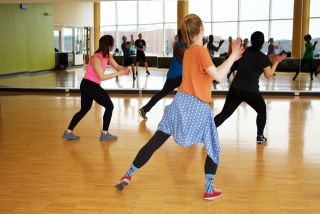Social Life
Need to Start a Gym Class but Can’t Seem to? Consider This
Group fitness offers multiple benefits beyond just fitness.
Posted August 15, 2024 Reviewed by Michelle Quirk
Key points
- Fitness classes provide essential social contact as well as fun.
- For some, a fitness class may deliver the only consistent social contact in an otherwise busy week.
- The sense of community offered in fitness class shouldn’t be underestimated.

A friend suggested I’d like a class at the neighborhood Community Center. I didn’t know that the name—SPF—stood for Senior Power Fit or my internalized ageism may have kept me away. I’m in pretty good shape and figured I’d crush it. I went on a Tuesday and we literally ran around the gym continuously, stopping just for jumping jacks or other highly aerobic moves, for the first half hour. It kicked my butt.
One woman recognized me and grew teary, remembering my face and name from 35-plus (!) years ago, when I’d sat with her in labor as a nurse-midwife. Another—the woman who invited me—introduced me around. Still another told me she takes two classes in a row several days a week because she’s retired and her husband works from home. It’s “for better or worse, but not for lunch” she agreed. I felt like I was at a party.
Turns out, this is par for the fitness course: Research confirms that group fitness provides a lot more benefits than helping our bodies stay healthy.
We understand socialization is critical for mental health. To each their own; extroverts crave social time more than introverts. Activities like fitness classes help us accomplish fitness and socializing: a double win. The social contact of fitness class enhances well-being more than just working out alone.
In group classes, you connect with people over time and can socialize if you like with new (or almost-new) friends, combatting isolation and loneliness, which are epidemic today. You can take this social process at your own pace, enjoying the hour or so together as enough or scheduling get-togethers outside class. When someone is absent, classmates often check on them, providing a sense of community and an informal safety net. While participants in class have a wide range of abilities, a good teacher ensures everyone feels accepted for who and where they are in an unpressured way.
Fitness class also offers a sense of belonging to a group with similar interests, something we all need. Fitness groups tend to be diverse—you meet and get acquainted with people you may not otherwise have met. Perhaps you even learn someone you care about in class has a political or ideological persuasion vastly different from yours. You know they’re a good person; this widens your umbrella of unity and civil respect for differences, actually combatting the dangers of polarization today.

The structure of fitness class ensures consistent social contact. Some participants have kids, work, and other responsibilities and can’t make class more than once a week. Others may be retired and enjoy more social structure. They can take additional classes as they like. For older women, for instance, one community fitness class was more important to participants for social rather than physical aspects, even though physical benefits were appreciated, too. This reliable social contact—even if you are just getting your workout in a group and don’t talk to anyone—can be a dependable source of emotional support and comfort.
One community-center fitness class is certainly not a panacea. But it’s a low-cost, low-risk, high-gain investment. Find a class that sounds fun and encourage yourself to go once, to see if you like it. Keep trying until you find a good fit. Then, enjoy and thrive.
References
Barragan C. Social relationships and the importance of community-based fitness programs (CBFP). J Women Aging 2021;33(4):428–441. 10.1080/08952841.2021.1915685


